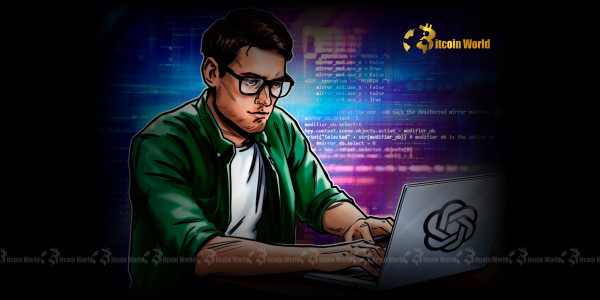OpenAI Security: A Pivotal Move Against AI Espionage and Data Leaks
0
0
BitcoinWorld

OpenAI Security: A Pivotal Move Against AI Espionage and Data Leaks
In the rapidly evolving landscape of artificial intelligence, where breakthroughs can redefine industries overnight, the value of proprietary technology has skyrocketed. For companies like OpenAI, which are at the forefront of this revolution, protecting their core assets is paramount. Recent reports indicate that OpenAI has undertaken a significant overhaul of its security operations, a decisive move to safeguard its valuable AI intellectual property against external threats and internal vulnerabilities. This isn’t just about keeping secrets; it’s about preserving the future of AI innovation.
Why is OpenAI Bolstering Its Security?
The decision to tighten security wasn’t made in a vacuum. The competitive intensity in the AI sector is unprecedented, with companies vying for every advantage. A key trigger for OpenAI’s accelerated security clampdown was the emergence of a competing model from Chinese startup DeepSeek in January. OpenAI alleged that DeepSeek improperly copied its models using ‘distillation’ techniques, a sophisticated method of extracting knowledge from a larger model. This incident underscored the urgent need for more robust defenses against corporate espionage.
Beyond direct copying, the threat landscape for AI companies includes:
- Nation-state actors: Governments are increasingly interested in acquiring advanced AI capabilities for strategic advantages.
- Competitor reverse-engineering: Rivals attempting to deconstruct models or algorithms to replicate functionalities.
- Insider threats: Disgruntled employees or those tempted by lucrative offers from competitors.
- Supply chain vulnerabilities: Exploits in third-party software or hardware used in development.
For OpenAI, protecting its groundbreaking models and research is not just a business imperative; it’s crucial for maintaining its leadership position in the global AI race.
How is OpenAI Enhancing its Data Protection?
OpenAI’s revamped OpenAI security measures are comprehensive, addressing multiple layers of protection from digital to physical. These strategies aim to create a formidable barrier around its most sensitive assets. Here’s a closer look at the key initiatives:
Information Tenting: Limiting Access to Sensitive Algorithms
One of the core changes is the implementation of ‘information tenting’ policies. This involves strictly limiting staff access to sensitive algorithms and new products. For instance, during the development of OpenAI’s o1 model, only a select group of verified team members, who had been ‘read into the project,’ were permitted to discuss it in shared office spaces. This compartmentalization ensures that only those with a direct need-to-know can access or discuss critical project details, significantly reducing the surface area for leaks or inadvertent disclosures.
Offline Systems and Biometric Controls: Fortifying Physical and Digital Perimeters
OpenAI is taking significant steps to isolate its most proprietary technology. This includes:
- Isolation in Offline Computer Systems: Critical proprietary technology is now stored and processed in offline computer systems, disconnected from external networks. This ‘air-gapping’ strategy is a highly effective way to prevent remote cyberattacks and unauthorized digital access.
- Biometric Access Controls: For physical office areas containing sensitive information, OpenAI has implemented biometric access controls, such as fingerprint scanning for employees. This adds an extra layer of physical security, ensuring that only authorized personnel can enter restricted zones.
‘Deny-by-Default’ Internet Policy: A Proactive Cybersecurity Stance
In a bold move to enhance cybersecurity, OpenAI has adopted a ‘deny-by-default’ internet policy. This means that all external connections require explicit approval. Unlike traditional security models that allow access unless specifically denied, this policy takes a proactive stance, minimizing potential vectors for data exfiltration or unauthorized external access. It’s a testament to a zero-trust approach, where every connection is viewed with suspicion until verified.
Increased Physical Security and Cybersecurity Personnel: The Human and Material Layers
Beyond digital and access controls, OpenAI is also reinforcing its foundational security elements:
- Enhanced Physical Security at Data Centers: Recognizing that data centers are the physical repositories of their most valuable assets, OpenAI has increased physical security measures at these locations. This could include more guards, advanced surveillance systems, and stricter entry protocols.
- Expanded Cybersecurity Personnel: The company is growing its team of cybersecurity experts. A larger, more specialized team can better monitor for threats, respond to incidents, and proactively identify vulnerabilities, ensuring continuous vigilance against evolving cyber threats.
The Broader Implications for AI Innovation and Corporate Espionage
OpenAI’s intensified security measures reflect a growing awareness across the tech industry about the immense value of intellectual property and the sophisticated methods employed in corporate espionage. While the primary concern might be foreign adversaries attempting to steal IP, these changes also implicitly address internal security issues, especially given the ongoing ‘poaching wars’ among American AI companies and past leaks concerning CEO Sam Altman’s activities.
This trend highlights a critical challenge: balancing the need for open collaboration and rapid development, which often characterizes the AI research community, with the imperative for stringent data protection. For other companies in the AI space, OpenAI’s actions serve as a blueprint and a warning. The era of loose security in AI development is over. Companies must invest heavily in comprehensive security frameworks to protect their innovations, which are increasingly becoming national assets.
What Can Other Companies Learn from OpenAI’s Proactive Security?
OpenAI’s comprehensive approach offers valuable lessons for any organization dealing with sensitive data or high-value intellectual property. Here are some actionable insights:
- Implement ‘Need-to-Know’ Principles: Restrict access to sensitive information to only those who absolutely require it for their work.
- Embrace Zero-Trust Architectures: Assume no user or device is trustworthy by default, requiring verification for every access attempt.
- Layered Security: Combine physical, digital, and procedural security measures for a robust defense.
- Regular Security Audits: Continuously assess and update security protocols to adapt to new threats.
- Employee Training: Educate staff on security best practices and the importance of IP protection.
By adopting similar proactive stances, companies can significantly mitigate risks and foster a more secure environment for their innovations.
Conclusion: Securing the Future of AI
OpenAI’s aggressive pivot towards enhanced security is more than just a defensive maneuver; it’s a strategic imperative in the high-stakes game of artificial intelligence. By fortifying its defenses against corporate espionage and internal vulnerabilities, OpenAI is not only protecting its own considerable investment but also setting a new standard for security in the AI industry. As the lines between technological advancement and national security blur, robust OpenAI security measures will become the bedrock upon which the future of AI innovation is built, ensuring that the fruits of labor remain with those who cultivated them. The battle for technological supremacy is increasingly fought on the cybersecurity front, and OpenAI is clearly ready for the challenge, emphasizing that robust data protection is non-negotiable for leadership in the AI era.
To learn more about the latest AI market trends, explore our article on key developments shaping AI models and their institutional adoption.
This post OpenAI Security: A Pivotal Move Against AI Espionage and Data Leaks first appeared on BitcoinWorld and is written by Editorial Team
0
0
 Manage all your crypto, NFT and DeFi from one place
Manage all your crypto, NFT and DeFi from one placeSecurely connect the portfolio you’re using to start.







